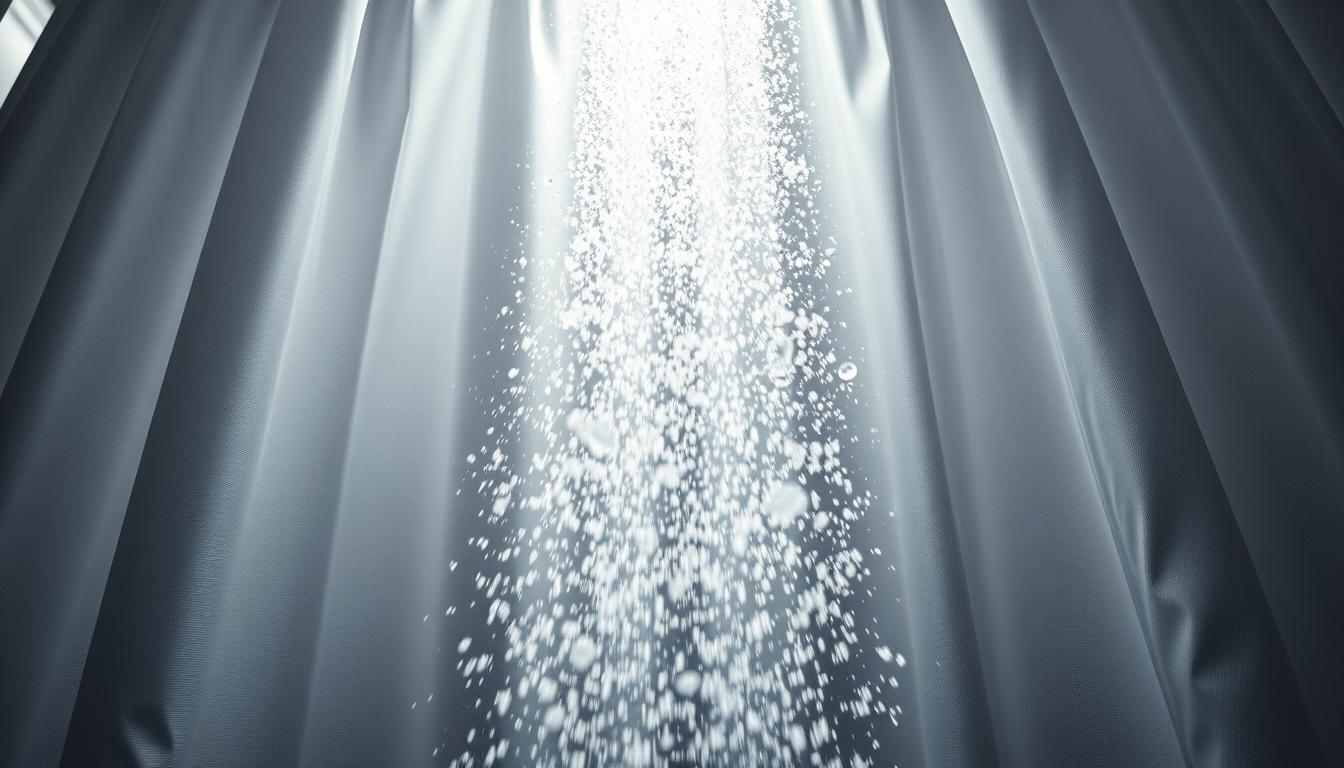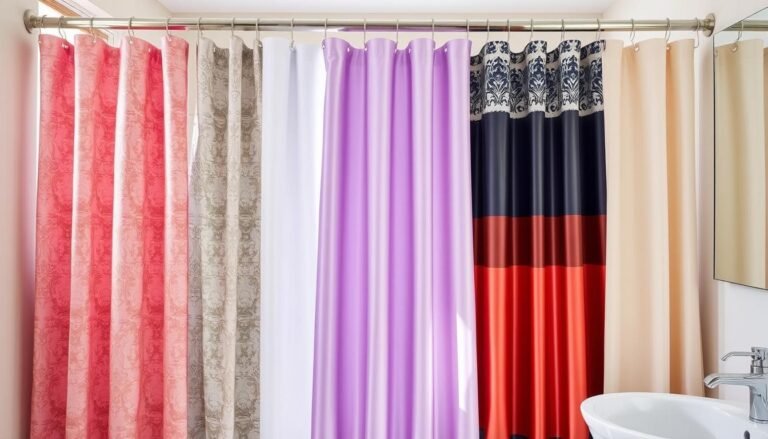Why Does the Shower Curtain Move Toward the Water?
The shower-curtain effect describes a curtain moving inward during a shower. It’s fascinating for both everyday people and scientists. It won the 2001 Ig Nobel Prize in Physics. This topic explores basic shower curtain physics and fluid dynamics.
Professor David Schmidt used $28,000 in software to study this. He figured it out with 1.5 trillion calculations. The Coandă effect explains the movement of shower curtains toward water.
This effect occurs with both hot and cold showers. Daniel Bernoulli first explained it in 1738. His work, Hydrodynamica, shows how airflow and pressure are related. This insight helps us understand water flow impact on shower curtains.
For more details on shower curtain science, check this informative article. It dives into different theories and practical tips.
Introduction to the Shower Curtain Effect
Have you ever noticed your shower curtain moving toward the water? This is known as the shower curtain effect. It’s a curious case that has grabbed the attention of scientists and everyday people alike. They explore why the curtain moves and what factors influence this behavior.
What is the Shower Curtain Effect?
When you turn on the shower, the curtain sometimes moves inward. This happens because the water flow creates a high-speed stream. This stream affects the air around it, lowering the air pressure near the curtain, which then pulls it inward. Understanding this can help us see how air and water interact in everyday settings.
Historical Observations and Studies
The science behind the moving shower curtain has intrigued many over the years. In fact, it caught the eye of viewers in Alfred Hitchcock’s “Psycho,” sparking even more interest. Research, including work by physicist David Schmidt, has used computer models to study this. They found that vortexes caused by the shower play a big role.
In his groundbreaking “Hydrodynamica,” Daniel Bernoulli explained how fluid speed and pressure relate. His principle tells us why a shower curtain might move inward as water speed increases, reducing nearby air pressure. It’s a real-world example of old scientific theories in action. Check out this resource for more on fluid dynamics.
Understanding Bernoulli’s Principle
The behavior of shower curtains is often linked to Bernoulli’s Principle. This principle is key in understanding many aerodynamics, like how airplanes stay up. It also explains the effect of water pressure on shower curtains.
Explanation of Bernoulli’s Principle
Bernoulli’s Principle tells us that faster fluid speed means lower pressure. In showers, water rushing from the head creates a low-pressure area. This makes the curtain move towards the water. Daniel Bernoulli, a Swiss mathematician, was the first to describe this in 1738.
Application to Shower Curtains
In showers, Bernoulli’s Principle brings the curtain inward as water flows quickly, creating a low pressure. David Schmidt and other researchers showed this effect using fluid-simulation technology. They divided the shower space into 50,000 tiny sections to capture 30 seconds of shower time. This showed how the water’s flow creates a low-pressure vortex.
Common Misconceptions
Though Bernoulli’s Principle explains a lot, it’s not the only reason shower curtains move. One common mistake is thinking it’s all about air pressure differences. Light curtains might be moved by air flow. But, heavy curtains or those in showers with low water pressure might not be affected the same way. Recent studies with new spray models reveal more forces at play, like horizontal vortices and the Coandă effect, also influence curtain movements.
| Explanation | Detail |
|---|---|
| Primary Cause | Increased water velocity creates low-pressure zones. |
| Simulation Findings | Spray-driven horizontal vortices and effect of droplet distortion on aerodynamic drag also play roles. |
| Common Misconception | Only air pressure differences affect curtain movement. |
| Additional Factors | Factors include the Coandă effect and water temperature’s minor influence. |
Other Theories Explaining Shower Curtain Movement
There are several theories about why shower curtains move inward during a shower. Beyond Bernoulli’s Principle, there are ideas like the buoyancy hypothesis, the horizontal vortex hypothesis, and the Coandă effect. Each offers unique insights into this curious phenomenon.
The Buoyancy Hypothesis
The buoyancy hypothesis suggests a simple idea. Warm air rising reduces air pressure in the shower area. Then, colder air outside pushes the curtain inward.
This shows how temperature changes affect air pressure and curtain movement. It highlights the role of pressure differences in this process.
The Horizontal Vortex Hypothesis
In 2001, David Schmidt, an assistant professor at the University of Massachusetts, won the Ig Nobel Prize. His work on the shower curtain effect was groundbreaking. He showed that a shower-induced vortex pulls the curtain inward due to a low-pressure zone.
This theory connects water flow to curtain movement. It shows the pressure difference created by the vortex’s suction.
Computational models showed the vortex from the shower spray creates low-pressure areas. This explains why the curtain moves inward, especially affecting lighter curtains. For more insights, visit this detailed analysis.
Role of the Coandă Effect
The Coandă effect deals with how fluid flows along a surface. For showers, it means water flow can make air follow the curtain, causing it to pull in. This, along with other factors, deepens our understanding of shower curtain movements.
Why Does the Shower Curtain Move Toward the Water?
Ever noticed how the shower curtain moves towards the water? This is known as the shower-curtain effect. It happens because of differences in air pressure caused by the water spray. The temperature of the water doesn’t really cause this.
Pressure Differentials and Airflow
The water spray from the showerhead makes the surrounding air move. This creates a whirlwind that lowers the pressure near the curtain, sucking it inwards. David Schmidt from the University of Massachusetts found this out using computer simulations. This shows that the flow of water is key in understanding why shower curtains move.
However, this force isn’t strong enough to pull all curtains. Light, thin curtains are more likely to be pulled in. But heavy curtains or those with magnets resist this force. There are even practical ways to stop this from happening.
Impact of Water Temperature
Temperature changes also play a role in moving shower curtains. Hot showers make the air expand, creating pressure differences. This, along with steam, affects how the curtain moves. But it’s not just about the temperature. The water vapor and the moving air also have a part in this.
- Steam makes the curtain billow out more.
- The size of your shower compared to the room matters.
- Air mixing inside and outside the shower changes curtain movement.
Want to dive deeper? Check out the Shower Curtain Effect online. You’ll find more theories and computer studies that explain this fun fact.
Practical Solutions to Prevent Shower Curtain Movement
Every day, many of us deal with shower curtains moving because of air pressure changes. The hot, moist air inside and the cooler, dry air outside make the curtain billow inwards. But don’t worry, there are several easy ways to stop this from happening, all tackling how water flow affects the curtains.
Heavy Curtains and Magnets
Using heavier fabrics for your shower curtain or adding weights does wonders. If you anchor the bottom with magnets or a heavy hem, the movement stops. Magnets or suction cups stick to the tub, especially good for acrylic or fiberglass ones, keeping the curtain place.
Shower Door Installation
A glass shower door is a solid and stylish fix. It acts as a barrier that makes a curtain unnecessary, solving the air pressure problem. Doors are popular for how well they work and their looks. Brands like Scudo, Roman, and Merlyn are known for their good customer feedback because of the quality experience they provide.
Low Curtain Rods and Curved Rods
Having your curtain rod lower or using a curved one makes a difference. Curved rods help spread the weight of the curtain, stopping it from clinging to you. Use extending rods for a snug fit, keeping heavy curtains in place. You can stop curtain movement by fastening suction cups with clips to the tub’s inside wall.
With these handy tips, your showers can be more peaceful. The effects of water flow on shower can be easily managed. These solutions promise a better, uninterrupted bathing time.

Hey there, I’m Alex Hanson and I’m passionate about all things covers! Whether you’re looking for a car seat cover to protect your vehicle or an oven cover to keep your kitchen clean, I’m here to help. With years of experience in the industry, I have plenty of knowledge and insights to share with my readers. So, if you care about protecting your belongings and making them look their best, you’re encouraged to read my blog as I explore the perfect cover for every need.







